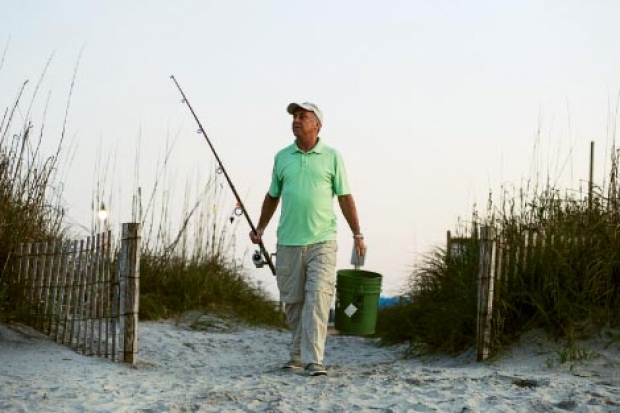Grab a rod and head to the beach for today’s fresh catch

Myrtle Beach may be the golf capital of the world, but the Grand Strand beaches always win top prize as the main reason tourists flock to these shores. Our beaches play host to surfers, boogie-boarders, sun worshipers, shell collectors and swimmers, as well as fans of an underappreciated activity—surf fishing.
Surf fishing is an experience which lends itself equally to the serious angler who uses multiple rods, baits and rigs to the casual angler who is happy sipping a beverage in a beach chair and watching his rod in its holder while enjoying the sunset. It can be done any time of day, but the best time is when the beach crowds are minimal—before 10 a.m. and after 5 p.m.
Want to try it out? Here are some tricks to help you increase your odds of catching a fish. But remember, the odds are always in your favor that you’re going to have a good time.
Where to Go
This may seem silly because there are more than 50 miles of beaches on the Grand Strand, but for the serious fisherman it is anything but silly. It is true that you can cast your bait anywhere along the beach and catch fish. The serious angler, however, studies the water and sand before making his or her choice.
By looking at when and where the waves are breaking, you can determine where the sandbars are located. In between the sandbars are deeper pockets of water in which the fish are more likely to congregate. These can be 100 yards off the beach or as close as 20 feet. Also, if you find a large deposit of seashells on the beach, it usually means the water directly in front of them is deeper. The more shells, the deeper the water.
Another option is to fish near the newly created near-shore artificial reefs. During the beach replenishment project, many of the drain pipes that discharged on the beach were extended several hundred yards underground off the surf and now discharge into an artificial reef. These reefs attract small fish, which in turn attract larger fish. Kayak fishermen have started to launch from the beach and paddle to these untapped fishing grounds, which have proved very productive for catching large flounder.
The reefs can be found at 14th and 52nd avenues north in Myrtle Beach, as well as at 25th Avenue South.
Equipment Needed
Most fishermen keep a basic setup ready for the surf. A plastic five-gallon bucket works great with a small, soft-sided tackle bag. The bucket should have a pair of needle-nose pliers, a bait knife, a cutting board, a hand rag, a PVC sand spike, a small shovel for digging sand fleas, and gallon-size zip lock bags. A cooler will hold your beverages and the fish you plan to keep for dinner.
The rod and reels can be anywhere from a medium action 6½-foot rod with 12-lb. test monofilament line to a 14-foot surf pole loaded with 50-lb. test braided line. Remember, sometimes your best fishing will only be 20 feet from the shore, so in this case bigger is not always better.
Rigs should consist of single or double drop bottom rigs with hook sizes 4, 2, 1/0 and 3/0. Pyramid sinkers in 2, 3 and 4 ounces are a must for holding the bottom, especially when the wind is howling.
It is always a good idea to have a couple of artificial lures handy in case a school of blues shows up. The 2-ounce Hopkins works well for casting into breaking fish.
Matching the Bait to the Fish
Depending on the size and species of fish that are biting, different baits are needed. Larger bluefish, redfish and flounder prefer a whole finger mullet, while whiting, pompano and sea mullet will hit pieces of shrimp or sand fleas. Small chunks of cut mullet are probably the best all-around bait and will catch just about everything that swims, if they are hungry enough.
Technique
The most effective way to fish the surf is to use different size rigs and bait at different distances from the surf. The rigs should have a heavy enough sinker so that they hold in place without being dragged down the beach with the wind and current. Let the rig stay in place until a strike is detected, or check your bait every 15 minutes to make sure you didn’t miss a strike and have had your bait stolen.
If you only have one rod, start out by casting past the breakers. If you don’t get a strike there, continue to cast closer to shore until you find the fish. And remember to use those pliers—sharks are not the only fish out there with teeth!
Early morning and late evening around high tide are the best times to catch fish. In the City of Myrtle Beach, fishing may only be done after 5 p.m. in areas where a lifeguard is present. All other areas along the Strand allow fishing any time, with the exception of Myrtle Beach State Park, which reserves the right to close the beach for fishing if it becomes too crowded. Common courtesy is the rule on the beach as swimmers and fishermen co-exist in their quest to have a good time and enjoy the natural resource.
A saltwater fishing license is required to fish in the surf. A non-resident, 14-day license is $11 and a resident 14-day license is $5. A yearly resident license is $10.
Licenses and bait can be purchased at any bait and tackle shop, as well as Bass Pro Shop and Walmart. Licenses may also be purchased online at www.dnr.sc.gov.